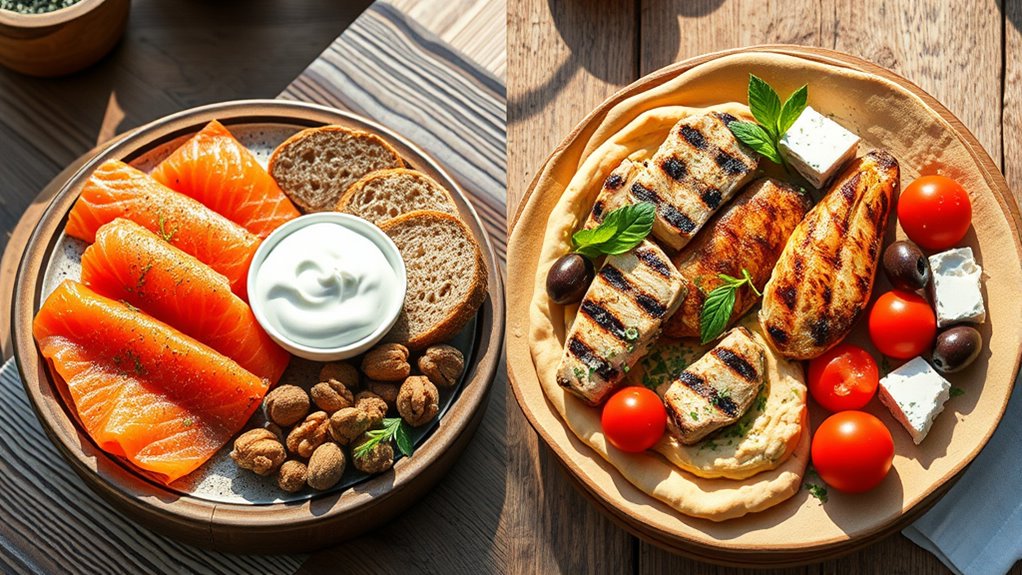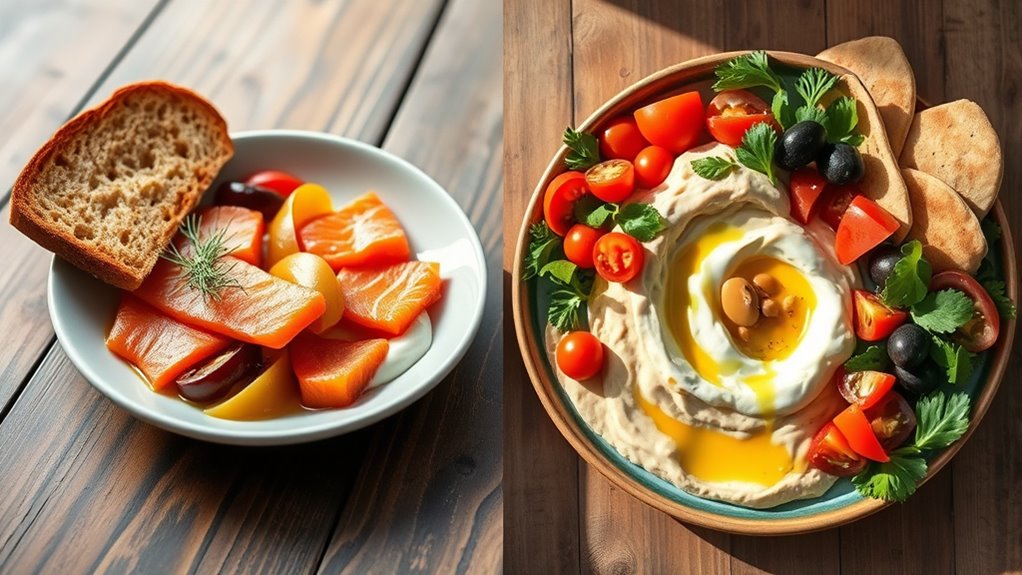The Nordic and Mediterranean diets both emphasize local, seasonal, and minimally processed foods, but they differ in ingredients and focus. The Mediterranean diet highlights olive oil, fruits, vegetables, and seafood, supporting heart health, while the Nordic diet focuses on wild berries, root vegetables, lean meats, and omega-rich fish. Both promote sustainability and social eating, but their long-term benefits and regional adaptation vary. Exploring more can help you choose the best approach for your lifestyle.
Key Takeaways
- The Mediterranean diet emphasizes olive oil, fruits, vegetables, and seafood, while the Nordic diet focuses on root vegetables, berries, whole grains, and wild foods.
- Mediterranean cuisine adapts to seasons with fresh summer produce and preserved winter ingredients; Nordic diet relies heavily on seasonal wild foods like berries and mushrooms.
- Both diets promote plant-based foods and sustainable, local protein sources—olive oil and seafood for the Mediterranean; canola oil, game meats, and wild fish for the Nordic.
- Scientific evidence strongly supports the Mediterranean diet’s benefits for heart health and chronic disease prevention; Nordic diet research is promising but less extensive.
- The Mediterranean diet emphasizes social, leisurely meals, whereas the Nordic diet encourages mindful eating and communal meal prep to foster healthy habits.
Core Principles and Food Focus of Each Diet

What sets the Mediterranean and Nordic diets apart in their core principles and food choices? The Mediterranean diet emphasizes whole foods like olive oil, fruits such as pomegranates and figs, and vegetables like tomatoes and peppers, reflecting warm-weather produce. It’s rooted in regional ingredients, highlighting olive oil and leafy greens. Additionally, the Mediterranean diet’s focus on nutritional balance ensures a variety of nutrient-rich foods for overall health. The Nordic diet, on the other hand, focuses on locally sourced, seasonal foods like root vegetables, berries, and whole grains such as rye and oats. Seafood plays a key role, especially fatty fish like salmon and herring. Both diets are plant-based and prioritize seafood, but the Mediterranean leans toward regional produce and olive oil, while the Nordic emphasizes wild foods, berries, and canola oil. Their core principles reflect their distinct climates and cultural traditions. Incorporating a variety of local ingredients is essential to understanding the unique identity of each diet. Recognizing the regional climate influences the availability and selection of foods integral to each tradition. The seasonal availability of ingredients also guides the traditional diets of these regions, shaping their nutritional profiles. Additionally, food preservation methods play a significant role in maintaining dietary variety across seasons.
Regional Ingredients and Seasonal Adaptations

You’ll notice that the Mediterranean diet adapts to seasonal changes by emphasizing fresh, locally available produce like tomatoes and citrus in summer. During cooler months, it shifts to preserved or region-specific ingredients such as olives, dried fruits, and root vegetables. Embracing local ingredients and seasonal variability helps keep the diet diverse and rooted in regional traditions. Additionally, incorporating regional ingredients can enhance the diet’s efficacy and flavor.
Seasonal Food Variability
Seasonal food variability plays a crucial role in the Mediterranean diet by emphasizing regional ingredients that align with local climate and harvest times. You’ll find it relies heavily on seasonal foods like tomatoes, pomegranates, figs, and dates, which peak during summer and early fall. This approach ensures you enjoy fresh, local produce at its best, supporting seasonal adaptation and reducing dependence on imports. Additionally, understanding compatibility factors can help tailor dietary choices to individual needs and regional availability. Incorporating seasonal food cycles into your meal planning can optimize nutritional benefits and enhance flavor profiles. Recognizing local harvest periods allows for better synchronization with natural food availability and supports sustainable eating habits. Embracing regional culinary traditions further enhances the diet’s adaptability to local environments and seasonal shifts. Considering food preservation techniques can also extend the enjoyment of seasonal produce throughout the year, ensuring a balanced diet regardless of harvest timings.
Both diets highlight food variability by focusing on ingredients available during specific harvesting seasons, reflecting their regional climates. Wild foods like berries and mushrooms also play a part in the Nordic diet’s seasonal cycle, harvested at particular times of the year.
This flexible, region-specific meal planning underscores the importance of food variability in maintaining a sustainable, healthful diet.
Local Ingredient Substitutions
Building on the idea of seasonal food variability, adapting ingredients based on regional availability allows you to enjoy authentic, nutrient-rich meals year-round. Using local ingredients and seasonal substitutions guarantees your dishes reflect regional foods and cultural traditions, enhancing authenticity.
For example, you might swap Nordic wild seaweeds for Mediterranean herbs or use frozen Nordic berries during winter, maintaining nutrient diversity and flavor. Incorporating locally sourced proteins like game meats or fresh fish supports seasonal eating and reduces environmental impact, promoting sustainability.
Flexibility in ingredient substitutions also helps you stay aligned with regional agriculture and climate, making it easier to stick with the diet long-term. By choosing regional foods, you not only preserve authenticity but also contribute to a more sustainable and diverse diet.
Health Benefits and Scientific Evidence

Numerous studies show that following the Mediterranean diet can considerably lower your risk of heart disease, certain cancers, and type 2 diabetes. The evidence is especially strong for its long-term benefits in improving metabolic health and reducing chronic disease risks. While some diets have limited data, the Mediterranean diet’s extensive research supports its role in promoting lasting health. Additionally, adopting leadership skills such as critical thinking and strategic planning can enhance your ability to make informed dietary choices and maintain healthy habits over time. Developing creative problem-solving techniques can help individuals navigate dietary challenges and stay committed to healthier eating patterns. Incorporating Best Modern Toilet principles, such as efficient water usage and proper maintenance, can also contribute to a healthier lifestyle by reducing unnecessary resource consumption and ensuring hygiene. Recognizing the health benefits of dietary patterns like the Mediterranean diet can motivate sustained adherence and improve overall well-being. Moreover, understanding the scientific evidence behind these diets can empower individuals to make choices grounded in research rather than trends.
Scientific Research Outcomes
How strong is the scientific evidence supporting the health benefits of the Mediterranean diet? It’s quite substantial. Extensive research links this dietary pattern to lower LDL cholesterol, reduced blood pressure, and decreased risk of cardiovascular disease. Meta-analyses show that its benefits in improving blood lipid profiles are well documented, thanks to decades of research outcomes.
The Mediterranean diet also appears to reduce inflammation, which is key in chronic disease prevention. While the Nordic diet shows promising results in lowering LDL cholesterol and blood pressure, its scientific evidence isn’t as extensive.
- *Research consistently links the Mediterranean diet to reduced cardiovascular risk.*
- *Both diets can improve blood lipid profiles, with the Mediterranean diet having more robust evidence.*
- *Emerging studies suggest the Nordic diet may help with inflammation, though more research is needed.*
Furthermore, the emphasis on content quality and topical authority enhances the credibility of research findings in both dietary patterns.
Long-term Health Impact
The long-term health benefits of the Mediterranean diet are supported by a strong body of scientific evidence, making it one of the most well-established dietary patterns for disease prevention. Extensive research links it to reduced risks of cardiovascular disease, chronic diseases, and certain cancers. Multiple large-scale observational studies and randomized trials have shown that following this diet can improve long-term health by lowering LDL cholesterol and helping maintain a healthy weight, consequently reducing obesity risk. Additionally, the structured nature of the diet promotes consistent adherence, which is crucial for sustained health benefits. The Mediterranean diet’s emphasis on whole foods and balanced nutrition further enhances its health-promoting qualities. The diet also benefits from regular health monitoring that helps individuals stay on track with their nutritional goals. While the Nordic diet is promising, its long-term health impact remains less conclusive due to limited research. Moreover, the use of data analytics in nutrition studies helps validate these health outcomes and track population health trends. Advances in nutrition research methods continue to shed light on how dietary patterns influence health over time.
Environmental Sustainability and Local Food Sourcing

Both the Mediterranean and Nordic diets prioritize locally sourced, seasonal foods, which considerably reduce the environmental impact of food transportation. By focusing on local foods and regional ingredients, you support sustainable practices that lower greenhouse gas emissions and energy use. Additionally, these diets promote food sourcing strategies that can help combat climate change. Incorporating practices like responsible harvest and seasonal eating further enhances their eco-friendliness, aligning with sustainable forestry and agricultural methods. The Nordic diet encourages the use of wild regional ingredients like berries, seaweeds, and root vegetables, promoting sustainable harvesting and biodiversity preservation. Similarly, the Mediterranean diet relies on locally produced olive oil, fresh herbs, and seasonal vegetables, aligning with eco-friendly agricultural methods. These diets help reduce reliance on processed and imported foods, further decreasing environmental footprints.
Protein and Fat Sources in Nordic and Mediterranean Plans

What makes the protein and fat sources in Mediterranean and Nordic diets uniquely suited for health and sustainability? Both diets focus on nutrient-dense fats and proteins that support your well-being.
The Mediterranean diet uses olive oil as its primary fats, offering heart-healthy monounsaturated fats.
The Nordic diet favors canola oil, which is rich in omega-6 fatty acids.
Both emphasize fatty fish like salmon, mackerel, and herring, providing essential omega-3s for brain and heart health.
For protein, the Mediterranean includes dairy products like Greek yogurt and cheese, along with poultry and seafood.
In contrast, the Nordic diet leans on lean meats, game, and fermented dairy like skyr and kefir.
Plant-based foods such as legumes and grains also play crucial roles in both plans, ensuring balanced, sustainable nutrition.
Additionally, understanding the history of pinball machines reveals how technological innovations and cultural shifts have influenced recreational activities over time.
Approach to Processed Foods and Social Eating Habits

Have you ever noticed how mindful eating and social meals are central to the Nordic and Mediterranean diets? Both emphasize limiting processed foods, sweets, and red meats to boost health.
The Mediterranean diet encourages savoring meals slowly with friends and family, creating social eating moments that enhance digestion and enjoyment.
Meanwhile, the Nordic diet promotes meal prep and communal dining at home, fostering a communal approach that supports mindful eating.
By focusing on whole foods and reducing processed options, these diets help prevent inflammation and chronic disease.
Sharing meals with others not only strengthens emotional well-being but also encourages healthier habits and longer-term adherence.
Ultimately, both approaches highlight the importance of mindful consumption and social connections in achieving a balanced, nutritious lifestyle.
Practical Tips for Incorporating Both Diets

To effectively incorporate the principles of the Mediterranean and Nordic diets into your daily routine, start by selecting seasonal, locally sourced produce like berries, root vegetables, tomatoes, olives, and citrus.
Use healthy fats such as olive oil and canola oil, prioritizing extra virgin olive oil for antioxidants.
Plan meals that include fresh fish at least two to three times weekly, choosing wild or canned options from the Nordic side and fresh or preserved from the Mediterranean.
Incorporate whole grains like rye, oats, and barley alongside whole wheat, farro, and bulgur to boost fiber.
Gradually add fermented foods such as Nordic sourdough bread, kefir, yogurt, and pickled vegetables to support gut health and flavor.
Effective meal planning guarantees diversity and balance in your diet.
Comparing Long-Term Adherence and Cultural Relevance

When choosing between the Mediterranean and Nordic diets for long-term adherence, cultural familiarity plays a crucial role. The Mediterranean diet’s deep-rooted traditions and widespread popularity make it easier to stick with over time. Its core foods, like olive oil, resonate emotionally and socially, strengthening dietary habits.
The Nordic diet’s emphasis on regional foods supports sustainability and cultural relevance for Nordic populations, helping maintain dietary routines. Both diets can adapt to regional foods and personal preferences, boosting adherence.
However, the Mediterranean diet’s longstanding tradition and familiarity often give it an edge for diverse populations. The Nordic diet’s regional focus appeals locally, but its relative novelty may challenge initial adherence in non-Nordic regions.
- Familiar foods foster emotional and social connections
- Cultural relevance boosts motivation for long-term adherence
- Regional foods support sustainability and dietary habits
Frequently Asked Questions
What Is the Difference Between the Nordic Diet and the Mediterranean Diet?
You want to understand how these diets differ. The Mediterranean diet emphasizes olive oil, region-specific vegetables, and warm-weather fruits like tomatoes and pomegranates.
The Nordic diet focuses on cold-climate produce such as root vegetables, berries, and wild foods.
Olive oil is the main fat in the Mediterranean, whereas the Nordic diet uses canola oil.
Both prioritize plant-based foods and seafood but reflect their unique cultural and environmental backgrounds.
What Is Considered the Healthiest Diet in the World?
When asked about the healthiest diet in the world, you should know that it depends on your personal needs and preferences.
Both diets emphasize plant-based foods, healthy fats, and seafood, promoting long-term health.
The Mediterranean diet has a longer track record with extensive research, while the Nordic diet is gaining recognition for its sustainability and recent health benefits.
Choose what suits your lifestyle and regional food availability for the best results.
Are Eggs Part of the Nordic Diet?
Imagine strolling through Nordic markets, where fresh, wholesome foods tempt your senses. Yes, eggs are part of the Nordic diet. You’ll find them in dishes like open-faced sandwiches and salads, offering high-quality protein and essential nutrients.
Moderation is key, so you’ll enjoy eggs alongside fish, lean meats, and legumes for a balanced, nutrient-dense meal plan. Eggs add versatility and crucial vitamins like D, B12, and choline to your diet.
What Diet Is Closest to the Mediterranean Diet?
You’re wondering which diet is closest to the Mediterranean diet. The answer is the Nordic diet, as both prioritize plant-based foods, whole grains, and moderate fish intake.
You’ll find similarities in their focus on local, seasonal produce—citrus and tropical fruits in the Mediterranean, berries and root vegetables in the Nordic.
While they differ in fats—olive oil versus canola oil—their overall emphasis on healthy, sustainable eating makes them quite comparable.
Conclusion
Choosing between the Nordic and Mediterranean diets depends on your tastes and lifestyle. For example, imagine someone in Scandinavia embracing local fish and root vegetables, finding it easy to stick with long-term. Both diets promote health, sustainability, and cultural connection. By understanding their principles, you can tailor your meals to suit your preferences, making healthy eating achievable and enjoyable. Whichever you pick, you’re taking a great step toward better well-being and a more sustainable future.









